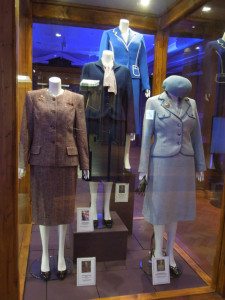The Devil is in the Detail
Clothes can tell a lot about the people who wear them. While it’s not exactly a detailed biography, a person’s wardrobe can leave enough clues if you care to look for them. Costume designers know that part of their job is to help tell stories and they use every trick of the trade available to get this done.
A lot of the time, the references are obvious, like the red-white-and-blue of Captain America’s costume or the macabre shape of the crown in Black Swan. But the most amazing details are sometimes the most subtle ones, and spotting these can add a whole new dimension to characters and stories we think we already know so well.
Take Trish Summerville’s work in The Hunger Games: Catching Fire. Katniss Everdeen (Jennifer Lawrence) is not only struggling to save her loved ones, she is also clearly fighting the effects of PTSD. The opening shows that anything remotely connected to the previous film’s Games can trigger a panic attack so it is reasonable to assume that being forced to visit the Capitol on a glorified Victory Tour must be one of the most difficult things for her to do.
She manages to keep her cool however and, if you look closely at her right hand, you will see why. In all the scenes involving the Capitol – and, crucially, not in any other location – Katniss is wearing a special metal cuff on her right hand. Pay careful attention and you will notice that she seems to clutch it tightly whenever things get claustrophobic.
The most amazing details are sometimes the most subtle ones, and spotting these can add a whole new dimension to characters and stories we think we already know so well.
A simple enough accessory, until you realise that the cuff looks exactly like her archery guard. So, not only does she have a personalised stress reliever, it is also a reminder of who she really is. She might be attending Capitol events wearing fancy couture gowns and ridiculous makeup but the real Katniss is still the archer, the perennial survivor.
Another clever use of costume design to tell us about a character’s arc is Consolata Boyle’s work in The Iron Lady. Bearing in mind that she had to recreate Margaret Thatcher’s (Meryl Streep) most iconic outfits, such as what she wore to the 1984 Conservative Party conference, Boyle was still able to inject some of her creativity into the project and give a knowing wink to the audience in the process.
From the moment she is elected as MP for Finchley until her last day in 10 Downing Street, Thatcher is seen to only wear the Conservative Party’s traditional blue. This in itself is not such a unique choice, but the intricacy is taken a step further by playing with the shade. Specifically, the later in her career she is shown, the darker the shade of blue and, by extension, the more conservative she is implied to be.
This is a case of artistic license as a quick scan through her political photographs shows that Mrs. Thatcher did not plan her wardrobe with quite such prophetic precision. On a different note, it also helps audiences recognise which part of her career is being referred to in specific flashbacks.
The work of the costume department is not just limited to enhancing character arcs. They can also give a feel for the world, often in nuanced and heart-breaking ways. In the alternate 1980s and 1990s of Never Let Me Go, the three protagonists, Kathy H. (Carey Mulligan), Tommy D. (Andrew Garfield) and Ruth C. (Keira Knightley) are all clones whose sole purpose in life is donate their organs so that their originals can live longer lives.
The social order reflects that, with the clones treated simultaneously as very valuable and also less than human. Part of creating this sense of separation between natural human and clone was the work of designers Rachael Fleming and Steven Noble, and it all came down to one chillingly simple detail. The clones all wear period appropriate clothing – including jackets that are one size too big for them. Just like their organs, their clothes do not fit.
Costumes are not just about putting menacing silhouettes on evil queens, making dapper suits for business moguls or creating over-the-top gowns for harried heroines. Just like every other aspect of behind-the-scenes work, they play an integral part to understanding how the story is shaped. And just like an Easter egg planted by the VFX crew or a clever use of dialogue by the screenwriter, the best bits are the subtle ones.



Comments